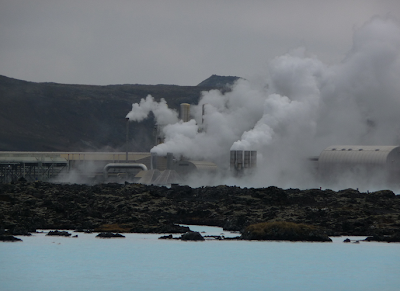Currently, these geothermal fields sparsely populate the Pacific Northwest, found as far inland as Northern Montana and Southern New Mexico. The largest of which is located at The Geysers in the Mayacamas Mountains just above San Francisco. As the world’s largest supplier of geothermal energy, the United States operates at an estimated installed capacity of 3,187 megawatts (MW) – enough energy to supply about 29% of New York City. This all, of course, made possible via the process of turning geothermal superheated fluid into steam used to rotate turbines, therein generating electricity.
So, that’s one method of extracting geothermal heat. Probably not something you would install in your backyard, right? Well, if you turn your focus away from the ground and direct it skyward you’ll find another geothermal energy supplier. The sun.
If you think about it logically, solar energy must pass through earth’s atmosphere before reaching surface level. Upon entering the atmosphere, about 23% of the solar energy disperses into atmospheric particulates (water vapor, dust, ozone, etc…). Because clouds, oceans and polar icecaps maintain reflective properties, roughly 29% of the energy redirects back into space. Finally, the remaining 48% is absorbed by the surface of the earth.
Because the earth rotates like a colossal rotisserie chicken, heat diffuses throughout the planet with higher concentrations at the equator that radiate outward toward each pole. On average, around the globe, ground temperature just below the surface – about 10 feet down – remains at a consistent 54? Fahrenheit year-round.
Similar to acquiring energy from deep within earth’s crust, we can access this superficial energy. However, the energy isn’t used to produce electricity but rather to regulate building air and water temperatures via geothermal heat pump heating and cooling systems. These systems, used primarily for residential purposes, can be scaled to outfit just about any type of building.
Like the name suggests, geothermal heating and cooling supplies warm air in the winter and cool air in the summer by taking advantage of stable ground temperatures. The aggregate system accesses secured ground heat via a heat exchanger, a looping of pipe filled with water or water-antifreeze solution installed below ground. The entire device is connected to your HVAC unit and an additional attachment known as an attemperation will kick-start your gas or electric water heater.
Geothermal Heating
In the winter when outside air temperatures begin to drop, geothermal systems work to provide hot air by taking advantage of warmer ground temperatures. Circulating fluid in the heat exchanger carries ground heat to the ground source heat pumps where it is concentrated and sent through the building’s HVAC unit. Traditional air source heat pumps demand large amounts of energy to provide necessary heat in the winter, whereas geothermal systems require less energy to produce the same effect.
Geothermal Cooling
In the summer when outside air temperatures begin to soar and humidity levels reach near 100%, geothermal systems work to provide cool air by taking advantage of colder ground temperatures. The cold liquid returning from the loop creates cool, dehumidified which is sent through the building’s HVAC unit. Again, traditional air source heat pumps demand more energy to force hot air out of the building and into already heat-saturated air.
Conversely to other renewable energy sources, access to geothermal energy is consistently reliable. When the sun disappears around the horizon, solar energy is impossible to access. When the wind loses its breath, wind farms do nothing more than look like motionless white giants. The benefits of geothermal heat are simple, elegant and practical. Plus, like most green initiatives, the government gives out nice tax cuts to people who use these systems. And most people like when they don’t have to spend their money on things like utilities and taxes.
This post was written by Mark Healey


